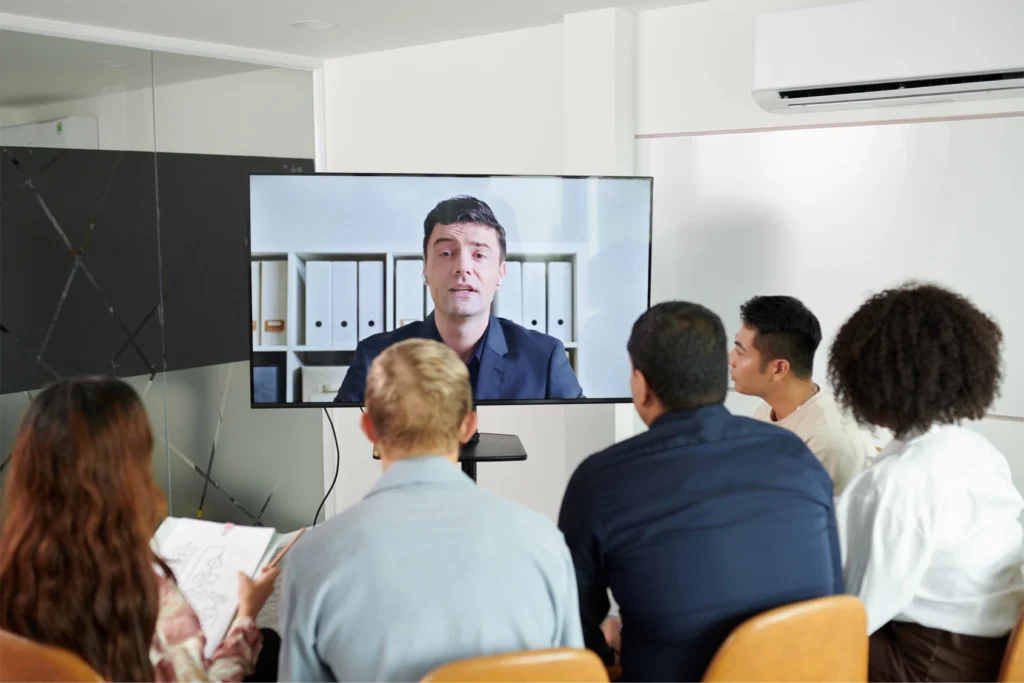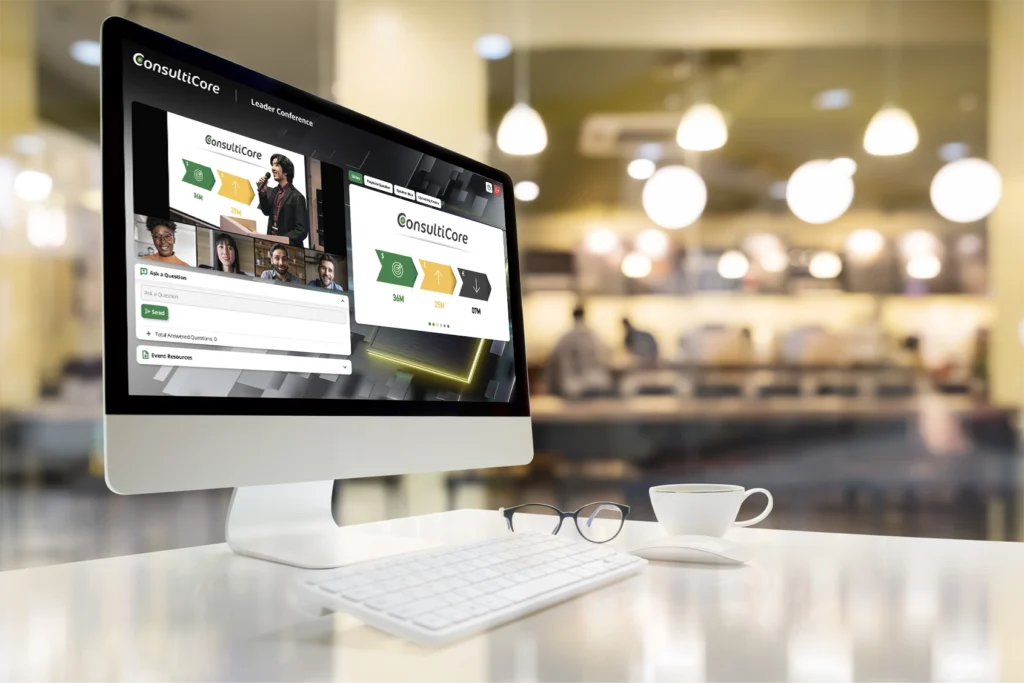
The Psychology of Virtual Events: What Drives Participation and Retention
- by GlobalMeet Blog Team
- ,
In recent years, virtual events have evolved from a stopgap solution into a permanent fixture of the events landscape. Whether it’s a multi-day virtual summit, a hybrid product launch, or a live-streamed training session, the success of these events hinges on more than just technology or content quality — it’s about psychology.
Understanding what drives people to sign up, show up, and stay engaged in virtual environments is crucial for any event organizer looking to improve virtual event retention.
Why Psychology Matters in Virtual Events
In traditional in-person events, social cues, environmental immersion, and physical presence help maintain focus and interest. Virtual events, however, must work harder to capture and keep attention, competing with distractions like email notifications, household responsibilities, or just the lure of another browser tab.
That’s where psychology comes in. By tapping into well-established cognitive and behavioral principles, virtual event organizers can design experiences that are not only engaging but also psychologically satisfying — encouraging people to participate more fully and stay for longer.
The Psychology Behind Participation: What Gets People to Show Up
Intrinsic and Extrinsic Motivation
Psychology defines motivation as having two key forms. Intrinsic, as coming from within the individual, and extrinsic, as coming from outside of the individual. It is vital to understand why your attendees are showing up for events, as this will show you how to make them stay, and return in future.
An intrinsically motivated attendee might sign up for virtual events to learn something new, meet their industry peers, or scope their competition. Extrinsically motivated attendees might be drawn by giveaways, exclusive content, or professional development credits that their company requires them to gain.
Knowing your attendees allows you to personalize your interactions with them, and ensure that your pre and post-event communications highlight the value that most resonates.
Social Proof and the Bandwagon Effect
Psychology Today defines The Bandwagon Effect as: “a psychological phenomenon whereby people do something primarily because other people are doing it, regardless of their own beliefs.” When combined with Social Proof, defined as “an informational influence (or descriptive norm) that can lead to herd behavior” it is clear to see why considering social influence in event planning could be critical.
By harnessing this knowledge virtual event planners can play to the psychology of potential attendees to increase engagement. Highlighting the current number of event registrants on a social post, or sharing keynote speaker spotlights may seem simple, but these actions build anticipation and participation by making potential attendees feel as though they are missing out, that they have to sign up because the rest of the industry is already attending.
Commitment and Consistency
In his 1993 Book Influence: Science and Practice, Robert Caldini wrote: “Once we have made a choice or taken a stand, we will encounter personal and interpersonal pressures to behave consistently with that commitment.” Though his research was conducted over thirty years ago, at a time when virtual events hadn’t even begun to develop, the principles of human behavior that be observed remain largely the same.
When viewed through the lens of virtual events, this analysis of behavior suggests that even a small initial engagement — like completing a pre-event survey or scheduling a single session — can build psychological commitment in the longer term. Using micro-commitments such as RSVP Polls, or downloadable personal agenda forms before an event can tap into this personal pressure, and increases the likelihood of eventual attendance.
What Keeps Attendees Engaged and Retained
Interactivity to Boost Engagement
The human brain craves stimulation, and harnessing that need can significantly boost event engagement. When attendees can engage actively with event content, rather than staring passively at a screen, they’re more likely to stay focused and remember what they learn. Polls, quizzes, Q&A sessions, and breakout discussions can all help keep the mind stimulated, and the participant engaged. Presenters have their own part to play in engagement, too. By addressing chat comments in real time and asking direct questions of the audience they can help virtual event attendees feel as though they are directly part of the experience.
Networking and Community Building
One of the biggest draws of in-person events is the chance to network. While this is harder to replicate virtually, effective networking opportunities can still significantly boost virtual event retention. By scheduling dedicated networking sessions, simple ‘meet your peers’ timeslots, and using AI tools for custom matchmaking, you can foster that sense of community and belonging that makes participants want to stay.
Gamification and Reward
Gamification taps into our competitive instincts and love of achievement. Leaderboards, point systems, scavenger hunts, and rewards for participation can add a fun layer to virtual events that can be the difference between a participant checking out, or staying to the end.
Implementing a points-based engagement tracker where attendees earn rewards for participating in sessions, engaging in chat, or downloading content — with tangible rewards at the end — can motivate your event participants to engage far more than a simple Q&A.
The Power of Exclusivity
Scarcity and exclusivity can create a psychological sense of urgency and value, even in virtual events where attendance could theoretically be unlimited. If something feels limited or special, regardless of whether it is, people are inherently more likely to prioritize it. By using language that implies exclusivity in your virtual event marketing, you can tap into that scarcity bias, and encourage potential attendees to act.
Managing Cognitive Load in Virtual Events
The American Psychological Association defines Cognitive Load as “the relative demand imposed by a particular task, in terms of mental resources required.” Virtual event attendees are particularly susceptible to cognitive overload as they are exposed to other loading factors such as screen fatigue, distractions, and dense information delivery.
But understanding cognitive load allows virtual event planners to build sessions mindfully, ensuring the best experience for participants.
Keep Sessions Concise and Focused: Long, unfocused sessions lead to overload, and disengagement. Aim for brevity and clarity in all content delivery, designing sessions around one or two key takeaways, and planning for interactive breaks at regular intervals.
Build in Breaks and Transitions: Breaks are essential to refresh attention and consolidate learning, so it is important to schedule short rest periods between sessions. Event planners could even offer optional mindfulness, wellness, or stretching sessions to reset attention spans and encourage continued engagement.
Segment Content for Better Absorption: Chunking — breaking information into manageable parts — is a common method to reduce cognitive strain and enhance memory retention. Use modular session design with clearly defined segments, group related content, and offer session replays or summaries to reinforce key points.
Best Practices for Leveraging Psychology in Virtual Events
Harnessing psychology to enhance your virtual events doesn’t have to be complicated. With just a few small changes to event design, participants are more likely to be engaged, and more likely to return.
- Design with motivation in mind: Understand what drives your audience and craft an experience that speaks to both their goals and incentives.
- Activate participation early: Use micro-engagements before and at the beginning of the event to spark involvement.
- Encourage social interaction: Incorporate networking and group activities to combat isolation and increase investment.
- Gamify the experience: Leverage competition, rewards, and progress tracking to increase involvement and satisfaction.
- Mind the mental load: Keep content digestible, pace the schedule thoughtfully, and provide re-engagement opportunities.
Conclusion
Virtual events are more than just static online meetings — they’re complex psychological environments that require intentional design. By understanding the core psychological principles behind human behavior, you can create events that not only attract attendees, but keep them actively involved from start to finish.
The future of virtual events lies in the fusion of technology and human psychology. Those who can master both will set a new standard for virtual event engagement and retention.

The Best Interactive Event Tools to Boost Engagement in 2025
- by GlobalMeet Blog Team
- ,
In 2025, remote and hybrid work are more than just trends — they’re the new norm. As teams continue to collaborate across time zones and screens, the need for engaging, efficient, and interactive event tools has never been greater. Traditional video calls no longer cut it; teams now expect features like live polling, AI assistance, Q&A functions, gamification, and seamless screen sharing to keep everyone engaged and productive.
Why Engagement Matters
We’ve all experienced the dreaded silent video call — faces staring blankly, microphones muted, multitasking rampant. Disengagement is a silent killer of productivity in the remote workplace. According to a 2021 study by BusinessWire, 85% of respondents stated that they sometime multitask during virtual meetings, with 44% reporting that they very frequently or always multitask during virtual meetings.
Interactive online event tools are designed to prevent this disengagement by enabling active participation. When participants are asked to vote in polls, join breakout sessions, or share feedback through chat and Q&A features, they’re more likely to stay focused, contribute meaningfully, and retain information.
Types of Interactive Features and Their Uses
Not all interactive features are created equal. Here are some of the most popular tools and how they enhance collaboration:
Live Polling
Polling is a quick and effective way to gather opinions, check comprehension, or make team decisions. It’s ideal for webinars, internal planning sessions, and virtual town halls where a large number of participants are likely to be in attendance.
Breakout Rooms
Breakout rooms promote deeper discussion in smaller groups, making them perfect for brainstorming sessions, training, and workshops. In 2025, platforms are increasingly adding smart features to assign participants automatically based on AI-matched criteria like department or interest.
Live Q&A
Rather than having participants unmute themselves and interrupt the flow of a meeting, live Q&A lets attendees submit questions during a presentation. Moderators can then review and publish these questions to ensure only relevant or appropriate ones are addressed.
Gamification
Gamified elements like leaderboards, badges, or quizzes turn routine meetings into something more engaging, integrating seamlessly into the flow of online events without compromising compliance for regulated industries.
Chat Features: What’s the Difference?
Not all chat is created equal. Understanding the difference between audience chat, event producer messaging, and presenter chat is crucial — especially for industries with strict compliance protocols like banking and finance.
Audience Chat
This is visible to all participants and is often used for open discussion, questions, and peer-to-peer engagement. However, it poses compliance risks in highly regulated industries due to the potential for unauthorized disclosures or inappropriate commentary.
Presenter Chat
This private channel is only visible to speakers and moderators. It’s useful for flagging time updates, off-script questions, or tech issues without interrupting the flow. Financial institutions may disable this to prevent unmonitored side conversations.
Event Producer Messaging
Reserved for behind-the-scenes communications, this channel allows technical producers or moderators to coordinate silently during an event. It’s especially valuable in high-stakes meetings like earnings calls or investor updates.
Many InfoSec teams — especially within banks — insist on disabling audience and presenter chat entirely for compliance. This has led platforms like GlobalMeet to create highly customizable configurations where meeting hosts can granularly control who sees what and when.
InfoSec and Compliance: Navigating the Challenges
In banking, insurance, and government sectors, information security (InfoSec) teams play a key role in approving virtual meeting tools. These teams often demand the ability to:
- Disable chat features entirely
- Limit who can screen share or record
- Require two-factor authentication for login
- Enforce data retention and access logs
Meeting platforms that don’t offer granular compliance controls are unlikely to pass security audits in these environments. That’s why tools like GlobalMeet are gaining traction — they offer enterprise-grade encryption, granular permissions, and robust audit trails, leaving organizers free to focus on their content, knowing that compliance is taken care of.
Choose GlobalMeet for Secure, Interactive Experiences
GlobalMeet stands out in 2025 for its balance of interactivity and enterprise security. Its suite of features is built with InfoSec-conscious clients in mind:
- Custom Chat Settings: Easily enable or disable audience, presenter, or producer messaging.
- Interactive Tools: From live polling and Q&A to on-screen annotations and gamification, GlobalMeet makes virtual meetings engaging without sacrificing control.
- Enterprise-Ready Security: With SOC 2 compliance, end-to-end encryption, and customizable data policies, GlobalMeet is a favorite among banks, law firms, and government agencies.
Conclusion
As the remote work landscape evolves in 2025, choosing the right interactive event tools can make the difference between a productive meeting and a wasted hour. Whether you’re drawn to AI-powered insights, robust compliance features, or creative ways to boost participation, there’s a system that fits your needs, and with tools like GlobalMeet, your virtual events can become more engaging, secure, and efficient than ever before.

The Business Benefits of Video: Why Webcasting Beats Traditional Video Conferencing for Enterprise Events
- by GlobalMeet Blog Team
- ,
In the evolving landscape of digital business communication, video has taken center stage. Whether you’re a global corporation or a growing startup, chances are you’re already using video in some form — be it for team check-ins, virtual client pitches, or company-wide updates. However, not all video communication tools are created equal.
While video conferencing platforms have become staples for daily interaction, they often fall short when businesses need to securely scale up their communication efforts. This is where video webcasting comes in — providing a powerful solution for hosting large-scale, professional-grade virtual event webcasts that enhance communication, reduce operational costs, and boost organizational efficiency.
Video Conference vs Video Webcasting: What’s the difference?
At first glance it would be easy to assume that Video Conferencing and Video Webcasting are almost the same thing. However, it’s essential to understand the core distinction between video conferencing and video webcasting when choosing the right fit for your organization.
Video Conferencing
A video conference is a real-time, interactive video call typically designed for small groups. It allows for two-way communication where all participants can speak, share screens, and interact equally. Video conferencing is ideal for:
- Daily team meetings
- 1:1 check-ins
- Brainstorming sessions
- Client presentations
Popular platforms include Zoom, Microsoft Teams, Cisco Webex, and Google Meet.
Video Webcasting
In contrast, video webcasting is a one-to-many communication format. It’s designed for broadcasting content to a large, often global, audience. Interaction may be limited to features like Q&A, polls, or chat moderation, and the host(s) typically have complete control over the presentation. Video Webcasts are ideal for:
- Company-wide town halls
- Investor relations events
- Product launches
- Training webinars
- Industry conferences
Webcasting platforms like GlobalMeet are built for scalability, security, and professional delivery.
Key Benefits of Video Webcasting
Improved Communication Across Distributed Teams
One of the major challenges in remote and hybrid work environments is ensuring consistent and clear communication. Video webcasting allows businesses to deliver high-quality, consistent messaging across all teams — regardless of geography or time zone.
Whether you’re rolling out a new strategy, delivering a leadership message, or conducting training sessions, webcasting ensures that everyone receives the same information, at the same time, in the same format. This level of consistency is difficult to achieve with traditional video conferencing, where message fidelity can vary depending on who is presenting or moderating the call.
GlobalMeet’s webcasting features, including HD video, branded templates, and multi-language support, help businesses maintain a polished and professional image while ensuring clarity and accessibility.
Cost Savings on Travel and Operational Expenses
Historically, business communication — especially for events — has come with a hefty price tag. Hosting in-person meetings, conferences, or training sessions involves venue hire, travel, accommodation, catering, and other logistics.
Switching to video-based virtual event webcasts significantly reduces these costs. Organizations can:
- Eliminate travel and accommodation expenses
- Reduce event staffing and logistics
- Cut down on time spent coordinating physical meetings
Companies that transition to video webcasting for large events could save an average of $1800 in travel and event-related costs per attendee. These savings can then be reallocated to strategic priorities like marketing, R&D, or employee development.
Enhanced Flexibility and Work-Life Balance
Today’s workforce values flexibility more than ever. By replacing in-person events with virtual alternatives, businesses give employees greater control over how they engage with work.
Video webcasting allows employees to tune into live broadcasts from anywhere or watch on-demand recordings at a time that suits them. This asynchronous flexibility supports diverse work schedules, minimizes disruption to daily tasks, and reduces stress related to travelling for event attendance.
By meeting employees where they are — both physically and professionally — companies foster a more inclusive and supportive work culture, leading to higher engagement and better outcomes overall.
Better Scalability and Audience Engagement
Traditional video conferencing tools often struggle to scale beyond 100–500-1000 participants without affecting quality or interactivity. Video webcasting platforms, on the other hand, are purpose-built to handle thousands of viewers simultaneously.
GlobalMeet, for instance, supports audiences of over 100,000 in full HD resolution with interactive tools like live polling, moderated Q&A, and surveys for post event analytics. These features allow organizers to create engaging, immersive experiences for large audiences — without compromising performance or accessibility.
In addition, video webcasting platforms often come with robust analytics dashboards, giving insight into attendee behavior, engagement rates, and content performance. This data is invaluable for refining future events and proving ROI of the webcast investment.
Improved Security and InfoSec Compliance
In the modern world of online working, security is an ever-growing concern, especially for industries handling sensitive data. While many video conferencing tools offer basic encryption, enterprise-grade video webcasting platforms go further with:
- Single sign-on (SSO) integration
- Access control and audience segmentation
- End-to-end encryption
- GDPR and SOC 2 compliance
These features are vital for financial institutions, healthcare providers, and multinational corporations, where InfoSec Compliance Standards will always be a priority.
Why Businesses Choose GlobalMeet for Webcasting
With so many platforms on the market, why are enterprises turning to GlobalMeet for their virtual events?
Here’s what sets GlobalMeet apart:
- Scalability: Host events from 500 to 100,000+ viewers with zero performance compromise.
- Customization: Brand your webcast with company visuals, colors, and messaging for a seamless audience experience.
- Ease of Use: A simple interface for both hosts and attendees, with intuitive tools and minimal technical barriers.
- 24/7 Support: Dedicated technical support ensures smooth delivery, from event planning to post-event analysis.
- Security First: Enterprise-grade security and compliance controls to meet the strictest corporate requirements.
As the #1 Trusted Webcasting platform of the Fortune 500, GlobalMeet gives you the tools to securely scale communication effectively, engage your audience, and operate more efficiently in a hybrid world.
Conclusion
As businesses continue to embrace hybrid work and digital transformation, the need for robust, scalable video solutions will only grow. While video conferencing remains essential for day-to-day collaboration, it’s no longer sufficient for large-scale communication needs.
Video webcasting delivers the scalability, professionalism, and security that today’s businesses require — helping teams stay connected, aligned, and productive no matter where they are. And with platforms like GlobalMeet, organizations have everything they need to make a smooth transition from traditional meetings to dynamic, high-impact virtual events.
If you’re looking to boost communication, cut costs, and future-proof your enterprise events, it’s time to make video webcasting a key part of your strategy.

Data-Driven Event Planning: Using Analytics for Better Engagement
- by GlobalMeet Blog Team
- ,
In the age of digital transformation, where every click, comment, and connection are trackable, event planning has entered a new era. Gone are the days when event success was gauged by gut instinct and post-event applause. Today, data-driven event planning is redefining how organizers design, deliver, and evaluate events — particularly in the fast-evolving world of virtual events. With the right approach to event analytics, planners can turn raw data into meaningful insights that drive engagement, improve attendee satisfaction, and optimize outcomes.
Why Data Matters in Event Planning
Events — whether conferences, webcasts, trade shows, or networking sessions — are rich with data. Every registrant, login, and question asked contributes to a digital footprint that tells a story. When captured and analyzed effectively, this data becomes a strategic asset that can significantly improve event management by providing detailed insights into consumer behavior, which in turn enhances marketing strategies and operational efficiency.1
Data helps event planners:
- Understand attendee behavior
- Identify which sessions resonate most
- Pinpoint drop-off points during virtual events
- Tailor content and communication to audience preferences
- Make smarter decisions for future events
This depth of insight available from every single event is a powerful tool for continuous improvement, with real time analytics allowing for dynamic adjustments during events to give participants more meaningful experiences. After the event, post event data enables trend analysis that can feed into future strategic decision-making, and higher return on investment with every subsequent event.
The Shift from Intuition to Analytics
Traditionally, event planning leaned heavily on experience, anecdotal feedback, and post-event surveys. Despite 90% of event planners and marketers reporting that they still use surveys to measure the satisfaction of participants, 19% still report that they do not know their ROI for events.
While these survey inputs are valuable, they are no longer sufficient on their own. The shift to data-driven decision making represents a fundamental change in how events are planned and measured.
Instead of simply asking “Did people enjoy the keynote?”, the collection of qualitative data allows planners to explore trends in more detail. Collecting data on such items as how many attendees watched a keynote, how long they watched, how many engaged with polls or Q&As, and how they scored the session as it closed, enables the creation of measurable metrics that can be used to track improvement in every event.
An analytical approach helps organizations move from assumption to evidence, facilitating continuous improvement and allowing for better resource allocation overall.
Key Event Metrics to Track
Understanding which metrics matter most is the first step in creating a data-driven event strategy that will allow you to learn as your events grow. Creating an overarching data framework for all events where every metric is tracked and analyzed facilitates continuous improvement, with better knowledge exchange between past and future events alleviating uncertainty.2
Below are some of the most critical metrics to monitor, especially for virtual and hybrid events.
Engagement Rates
Engagement is the heartbeat of a successful event. In virtual environments, where distractions are high and attention spans short, tracking how attendees interact is essential. Common engagement indicators include:
- Chat and Q&A participation
- Poll response rates
- Number of virtual session attendances
- Social media shares and mentions
- Participation in gamification segments
High engagement suggests that content is relevant, the format is effective, and the audience is invested. Whilst low engagement provides metrics on which to improve for future events.
Session Attendance
Tracking which sessions attendees join — and for how long — offers insight into content relevance and scheduling effectiveness. Look for:
- Total session attendees
- Peak concurrent attendance
- Session drop-off rates
- Re-watch numbers for recorded sessions
These metrics can inform future content curation, and can help identify which topics or speakers drive the most interest from a target audience.
Audience Retention
Retention metrics show how well an event holds attendee attention. For example, a 60 minute session with an average watch time of 15 minutes may signal a need for a shorter format or more dynamic content delivery style.
Tracking retention can also help organize segment attendees by interest or engagement level, which opens the door to dynamic and post-event personalization.
Feedback and Sentiment
Quantitative metrics are powerful, but qualitative data — like attendee feedback — adds essential context to the mass of numbers. Gathering real-time feedback via surveys, live polls, or post-event questionnaires helps you:
- Understand attendee satisfaction
- Identify pain points
- Highlight what worked well
- Capture improvement suggestions
Some advanced platforms also use AI-driven sentiment analysis to evaluate tone and emotion in written feedback or chat logs.
Combining both data sets for meaningful analysis gives you the best insight possible into your audience, and how to better reach them.
Tools for Data-Driven Event Management
Today, state-of-the-art event technology offers a variety of platforms and tools designed specifically to capture and analyze the data that matters most to your organization at every stage of the event lifecycle.
Event Management Platforms
Specialized bespoke event management platforms are going from strength to strength when it comes to capturing and managing your event data.
Tools like GlobalMeet not only integrate into existing CRM systems, but also offer a suite of built-in analytics dashboards that track:
- Registration and attendance data
- Engagement metrics
- Conversion rates
By utilizing a powerful platform with good CRM integration, event data not only informs future events, but allows for cross collaboration between teams for broader business growth.
Audience Engagement Tools
Platforms that contain or integrate with interactive elements are an excellent resource for collecting analytics on participation rates and audience engagement. A poll, quiz, or Q&A might be easy to overlook on the surface, but the data that they provide are invaluable for understanding your audience, and connecting on a deeper level.
Marketing and CRM Integrations
Connecting event data with tools like HubSpot or Salesforce allows event planners to:
- Track attendee behavior across channels
- Score leads based on engagement
- Trigger personalized follow-ups based on session attendance or pole responses
And with many CRM systems allowing for process automation, event planners can save valuable time by making the best use of them.
AI and Predictive Analytics
Some platforms are beginning to use AI to:
- Predict which sessions will have the highest attendance
- Recommend personalized content to attendees
- Suggest optimal timing and formats based on historical data
This technology adds another layer of analytics information, helping planners stay ahead of audience expectations and mitigate potential issues before they arise.
Personalization Strategies Based on Attendee Data
One of the biggest advantages of data-driven event planning is the ability to create personalized experiences for every attendee. Rather than taking a one-size-fits-all approach, data allows planners to segment their audiences and tailor content accordingly.
Before the Event
Use registration data and past engagement history to:
- Recommend sessions or tracks
- Personalize event communications
- Match attendees with relevant networking opportunities
During the Event
Real-time engagement data enables:
- Dynamic content delivery (e.g., pop-up polls or suggested sessions)
- Customized agendas based on behavior
- Adaptive push notifications and reminders
After the Event
Post-event, data enables:
- Personalized thank-you emails
- Targeted follow-up based on session attendance
- Lead scoring for sales teams based on engagement levels
By making attendees feel seen and understood, personalization enhances satisfaction and increases the likelihood of repeat attendance.
Conclusion
As virtual and hybrid events become more sophisticated, the use of event analytics is no longer optional — it’s a competitive necessity. Planners who embrace data-driven strategies will be better equipped to:
- Prove ROI to stakeholders
- Fine-tune their content and delivery
- Create memorable experiences that resonate with their audience
Ultimately, data empowers event planners to move from reactive to proactive, from general to personalized, and from guesswork to precision. As event technology continues to evolve, the opportunities to deepen engagement through analytics will only grow.
-
Gajdošík, T. 2019. Big Data Analytics in Smart Tourism Destinations. A New Tool for Destination Management Organizations? Springer Proceedings in Business and Economics, 15–33.
-
Müller, M. 2015. The Mega-Event Syndrome: Why So Much Goes Wrong in Mega-Event Planning and What to Do About It. Journal of the American Planning Association, 81(1), 6–17.

How to Make Virtual Events More Engaging: Tools, Tips & Best Practice
- by GlobalMeet Blog Team
- ,
In an era where remote work and virtual events have become the norm, one question remains at the forefront of every host’s mind: how to make virtual events more interactive and engaging. Whether you’re running a team check-in, a client workshop, or a virtual event with hundreds of participants, event engagement can make or break the success of your session.
Bland, one-way communication isn’t just ineffective — it leads to distracted attendees, reduced productivity, and missed opportunities for collaboration. But with the right strategies and technology, you can turn routine online events into dynamic experiences that keep participants focused, involved, and even excited.
Common Virtual Event Engagement Challenges
There are a number of reasons why virtual events often fall flat. Understanding these reasons is half of the journey towards better, more engaging virtual events.
Passive Participation
Too many virtual events rely on a single speaker and a sea of muted microphones. This passive format discourages interaction and makes it easy for attendees to zone out. The solution is simple. Break up the monotony. Incorporate regular participation opportunities such as polls, Q&As, or short discussion prompts.
Screen Fatigue
Long sessions filled with back-to-back slides drain attention spans. The average participant starts checking emails within 10 minutes if there’s no interaction. So, the best approach is to keep events concise and varied, and use a mix of content formats — videos, whiteboards, breakout discussions — to hold attention.
Technical Barriers
Unfamiliar platforms or lack of accessibility features (like captions or mobile-friendly interfaces) can exclude or frustrate attendees. Choose tools that are intuitive, built with accessibility in mind, and are easy to access from any device.
Lack of Structure
Virtual events without a plan can feel chaotic or directionless, especially for larger groups. Always share an agenda in advance and stick to a structured flow that includes time for interaction.
Why Interactive Elements Matter in Virtual Events
Virtual doesn’t have to mean disconnected. When events are designed with interactivity and engagement in mind, you unlock several benefits:
- Increased focus: Interactive features reduce multitasking and increase information retention.
- Better collaboration: Real-time feedback and discussion foster deeper engagement.
- Higher satisfaction: Attendees leave feeling heard and involved, not talked at.
- Actionable insights: Tools like polls and live chat give you valuable input from attendees.
In short, adding interactive components helps recreate the collaborative energy of in-person meetings in a digital space.
Tools and Techniques to Boost Virtual Event Engagement
Creating truly engaging virtual events is about more than just the content that you’re sharing. It requires a partnership of thoughtful facilitation, and the right tools.
Breakout Discussions
Breakout rooms allow for small group discussions, brainstorming sessions, or focused tasks. They’re ideal for smaller team retrospectives, icebreakers and networking, and problem-solving discussions. With clear instructions and a facilitator assigned to each room they can make a real impact.
Live Reactions
Simple but powerful — reactions like thumbs-up, applause, or emojis give participants a way to respond instantly without interrupting the flow. This helps presenters read the virtual room and adapt their style on the fly.
Polls and Quizzes
Live polls engage attendees by asking for opinions or checking knowledge. These are perfect for keeping the energy high and gauging audience sentiment. Use polls to kick off a discussion or wrap up a section with a quick knowledge check to ensure that your participants are paying attention.
Gamification
Adding game-like elements — points, leaderboards, scavenger hunts, or virtual badges — makes learning and participation a little more fun. You can use gamification during training or team-building sessions to boost involvement.
Virtual Whiteboards
Collaborative Whiteboards are an often underused tool, but they can be a gamechanger in smaller scale virtual meetings where real-time collaboration is king. Map out tasks, visually brainstorm and co-create in real time, and co-design workflows seamlessly with screen sharing to talk through the more complex elements.
Best Practices for Structuring an Engaging Virtual Event
Even with the best tools, event engagement will lag without thoughtful planning. Here’s how to structure events that foster participation from the start.
Set Clear Objectives: Start with the outcome in mind. What should participants walk away with? Tailor your interactive elements to support those goals.
Design for Participation: Make interactivity a requirement, not a bonus. Plan intentional moments for audience involvement every 5–10 minutes.
Use an Experienced Moderator: Whether it’s a facilitator or co-host, someone should guide the discussion, manage chat questions, and ensure all voices are heard.
Mix Presentation Styles: Break your meeting into segments — slides, videos, breakout groups, polls — to maintain energy and avoid fatigue.
Close with Engagement: Wrap up with a final poll, word cloud, or round of reflections to give everyone a voice and reinforce takeaways.
Elevate Virtual Meeting Engagement with GlobalMeet
Interactive Engagement Features
From live polling and Q&A to real-time reactions and content sharing, GlobalMeet makes it easy to involve participants throughout your event.
Live Transcription and Summaries
Never miss a beat with live captions, automated meeting transcripts and key point summaries — great for keeping everyone aligned.
Enterprise-Grade Security
When it comes to virtual event engagement, InfoSec compliance matters. GlobalMeet meets rigorous enterprise security standards, giving IT peace of mind.
Whether you’re hosting a high-stakes webinar or a recurring team sync, GlobalMeet helps ensure your virtual events are more than just video calls.
Conclusion
Virtual and hybrid events are here to stay, but they don’t have to stay boring. With the right structure, tools, software, and intention, you can build interactive webcasts and events that boost engagement, spark innovation, and deliver better outcomes every single time.

CPD and Training: The Growing Role of Virtual Events in Professional Development
- by GlobalMeet Blog Team
- ,
In a world where skills evolve rapidly and industry standards update frequently, Continuous Professional Development (CPD) has never been more important. For professionals aiming to stay competitive and relevant in their fields, regular training is essential. Traditionally, this meant attending in-person workshops, seminars, and conferences to maintain mandatory training compliance standards. But in recent years a dramatic shift has occurred. Virtual events are now transforming how individuals and organizations approach CPD, offering more accessible, flexible, and scalable learning solutions.
From live webcasts to immersive certification courses, virtual learning environments are empowering professionals across sectors to pursue ongoing development without the constraints of travel, time, or budget.
The Shift to Virtual Training
The global pivot to remote work during the COVID-19 pandemic sparked a massive wave of digital transformation, and one area that underwent significant evolution was professional development and training. Organizations that once relied on in-person seminars and training sessions were forced to explore digital alternatives, revolutionizing the training industry forever.
What began as a temporary necessity soon became a long-term strategy with companies across professional industries recognizing the value of virtual CPD events. With benefits from cost savings and time efficiency, to broader participation opportunities and better tracking, it’s clear to see why the move to virtual CPD has become so popular with the global workforce.
Today the trend continues. The rise of hybrid work environments combined with the increasing globalization of teams has resulted in virtual events no longer being seen as second best, with Think Learning reporting that 73% of L&D professionals expect to spend less budget in the future on instructor-led training, while 79% expect to spend more on online learning. Far from being the secondary option, Virtual Events are emerging as the preferred choice for delivering high-quality professional training at scale.
Why Choose Online Learning?
Virtual learning offers a number of advantages over traditional in-person training, making it a compelling alternative, or complimentary, choice.
Flexibility and Convenience
With virtual learning events professionals can attend training sessions from anywhere in the world, allowing them to slot training and development effortlessly into their already busy schedules. The LinkedIn 2018 Workplace Learning Report notes that 58% of employees prefer opportunities to learn at their own pace, whilst 49% prefer to learn at the point of need, making virtual learning an obvious choice. Whether that’s during flex time, or fitted around other commitments, virtual learning offers dynamic scheduling to ensure that time isn’t diverted away from key responsibilities.
Scalability
Virtual CPD events can reach hundreds — or thousands — of participants simultaneously, with state-of-the-art software platforms providing bespoke set up and support for ease of use. This makes them ideal for large organizations that need to roll out consistent training across multiple departments or geographic regions, without sacrificing event quality.
Cost-Effectiveness
Without the overheads of venue hire, catering, hotel, printing, and travel expenses, virtual events offer a more budget-friendly and sustainable solution. This cost reduction can increase access to training for more staff, and allow for investment in higher-quality content for future events.
Personalized Learning
With the aid of learning management systems (LMS) and AI-powered tools, the best virtual event platforms can tailor content to individual learners, making the experience more interactive, engaging, and accessible. Whether through adaptive quizzes or personalized modules, online learning is often more able to meet diverse professional needs when compared with traditional in-person training.
Types of Virtual CPD Events
There’s no one-size-fits-all approach to CPD, and the beauty of virtual learning is that it accommodates a wide range of formats, allowing organizations to mix and match according to their goals and the needs of their individual teams.
Webcasts
Live, SimLive, or on-demand, webcasts are an excellent tool for delivering thought leadership sessions, compliance training, or product updates. They typically feature a host and guest speaker(s), and offer opportunities for Q&A and live polling to keep attendees engaged.
Online Workshops and Webinars
Webinars are usually smaller than Webcasts and tend to encourage more active participation. These sessions might include breakout groups, real-time collaboration tools, or project-based tasks. They’re ideal for developing soft skills, team-building, or applying theory to practice.
Certification Courses
Professional certification is a key component of CPD. Many platforms now offer comprehensive virtual courses — complete with assessments and credentials — that are fully accredited. These are popular in fields such as IT, healthcare, legal, and finance, where regulatory compliance is essential.
Virtual Summits and Conferences
Larger-scale virtual events bring together multiple sessions, speakers, and networking opportunities. These summits often feature virtual keynote sessions, downloadable resources, and community spaces, creating a rich and immersive learning environment. They also allow for global participation and can be recorded for on-demand access, making them a great resource for the future.
Benefits of Virtual CPD
Virtual CPD isn’t just a convenient alternative — it also offers strategic advantages for individuals and organizations.
For Professionals
Improved Access: Regardless of location or physical ability, professionals can attend world-class training events from the comfort of their own homes or offices.
On-Demand Learning: Online sessions are often recorded, allowing for knowledge checks, recap sessions, and more flexible learning at a pace that suits the individual.
Broader Exposure: Virtual events often include international speakers and attendees, offering a wider perspective on industry trends than would be possible at a traditional event.
Trackable Progress: Many platforms provide digital badges or certificates, making it easier to document CPD activities for career progression or regulatory bodies.
For Organizations
Upskilling at Scale: Companies can train large numbers of staff efficiently, ensuring consistency in knowledge and compliance across global teams.
Talent Retention: Offering CPD opportunities is a proven strategy to boost employee engagement and satisfaction, making valuable staff more likely to stay.
Data and Insights: With the right tech stack, organizations can track attendance, engagement, and learning outcomes — valuable data for refining L&D strategies and meeting continuous improvement targets.
Sustainability: Reducing travel and paper use helps organizations meet their sustainability goals.
Leverage Virtual Events to Upskill Your Workforce
To get the most from virtual CPD, organizations need to adopt a strategic approach. Here are some best practices to consider:
Align Training with Business Goals
Identify skill gaps that align with business objectives. Whether it’s digital transformation, compliance, or leadership development, ensure CPD initiatives support broader organizational needs.
Use the Right Technology
Invest in platforms that support interactivity, scalability, and analytics. Features like real-time quizzes and certificate tracking can elevate the learning experience.
Promote a Learning Culture
Encourage employees to take ownership of their own development. Celebrate completions, share success stories, and provide time during the workday for training activities wherever possible.
Curate Engaging Content
Mix formats and topics to maintain engagement. Consider bringing in external experts, offering microlearning content, or adding gamification elements to keep attendees interested.
Evaluate and Adapt
Gather feedback, measure outcomes, and be ready to adapt whenever required. Virtual CPD should be a dynamic process that evolves with employee needs and organizational priorities.
Conclusion
The way we learn at work is changing. As the demand for Continuous Professional Development grows across industries, virtual events are proving to be an invaluable tool. They remove traditional barriers to education — geography, time, and cost — and unlock new possibilities for lifelong learning.
By embracing virtual learning, professionals can stay ahead of industry trends, meet compliance requirements, and advance their careers with greater ease. Meanwhile, organizations can build agile, skilled workforces ready to meet the challenges of tomorrow.

Why Webcasting Is Important for Your Global Business Expansion
- by GlobalMeet Blog Team
- ,
In today’s fast-moving global economy, expanding into international markets isn’t just an ambitious goal — it’s a strategic necessity. But with opportunity comes complexity, especially when it comes to managing communication across diverse time zones, languages, and cultures. That’s where webcasting steps in.
From web conference meetings to large-scale video webcasting, these technologies offer businesses the ability to securely communicate clearly, consistently, and cost-effectively across borders. Webcasting is no longer just a technical solution — it’s a strategic enabler for global business growth.
The Strategic Role of Webcasting in International Expansion
Global expansion means engaging customers, partners, and employees in multiple locations. In-person meetings are often impractical due to cost, time, and logistical hurdles. Webcasting bridges these gaps by enabling companies to deliver live and on-demand content to distributed audiences with minimal effort.
Overcoming Geographical Barriers
A traditional challenge for global businesses is how to communicate with distributed teams and external stakeholders in real time. Time zones, distance, and availability can all complicate even the most routine interactions.
Webcasting, along with hybrid and virtual events, offers a scalable solution to this problem. Companies can host live web conference meetings for instant collaboration, leverage on demand video webcasts for asynchronous viewing, or invest in hybrid events that combine in-person and online elements to ensure everyone can participate, regardless of location.
These tools make it easy to reach international teams, host multilingual events, and deliver consistent messaging to all markets simultaneously.
Supporting Key Business Events
Webcasting is not a one-size-fits-all tool — it’s a versatile platform that supports a wide range of strategic communication needs.
Town Hall Meetings
Global companies rely on regular town halls to align employees, build culture, and communicate strategic priorities. Webcasting allows leaders to speak directly to thousands of employees across the globe, either live or through recorded sessions that employees can watch on their own time.
R&D Days
Research and Development (R&D) efforts are increasingly collaborative and international. Webcasting enables researchers, engineers, and stakeholders from different countries to share updates, review data, and innovate in real time—without the delays and costs of travel.
New Product Introductions
Launching a new product globally requires a coordinated communications effort across sales, marketing, and customer service teams. Video webcasting makes it easy to train internal teams, build excitement with partners, and deliver product demonstrations to media and customers in multiple regions at once.
Reducing Travel Costs and Environmental Impact
Travel is expensive — not just in terms of cost, but also in time and carbon footprint. As businesses aim to meet both budget and sustainability goals, webcasting offers a compelling alternative to frequent international flights and large physical events.
Cost Savings from webcasting include:
- Lower airfare and accommodation expenses
- Fewer logistical costs related to venues, catering, and event staffing
- Reduced productivity loss from employee travel
The Environmental Benefits are equally compelling:
- Decreased carbon emissions from flights and ground transportation
- Smaller physical event footprints, which means less waste and resource usage
- Support for corporate sustainability goals and green certifications
These advantages make webcasting not only a smart financial decision but also a socially responsible one.
Key Features to Look for in a Webcasting Solution for Global Teams
Not all webcasting platforms are created equal — especially when it comes to supporting the needs of globally distributed teams. When choosing a solution, it is vital to consider several essential features.
Scalability
Whether you’re addressing 500 people or 100,000, your webcasting solution should handle large audiences without compromising quality or performance. Look for platforms that offer cloud-based scalability and global content delivery networks (CDNs).
Accessibility
A global audience includes people with different languages, abilities, and tech access. Your platform should offer:
- Multi-language support and live translation
- Mobile-friendly interfaces
- Screen reader compatibility
- Live audio-captioning
Security
When you’re sharing sensitive business information, security is non-negotiable. Choose a solution that offers:
- End-to-end encryption
- Role-based access control
- Compliance with global standards like GDPR, HIPAA, and SOC 2
Interactivity
Keep your global audience engaged with interactive features like:
- Live Q&A and polls
- Chat functions
- Real-time feedback tools
These features turn passive viewers into active participants, improving information retention and creating a sense of community across borders.
Analytics
Data is critical for continuous improvement. Look for solutions that offer robust reporting tools to track:
- Attendance and participation rates
- Engagement metrics (e.g., poll responses, chat activity)
- Viewing behavior (e.g., average watch time, drop-off points)
These insights can help you refine future webcasts and better serve your global audience.
How GlobalMeet Supports Global Business Growth
GlobalMeet is the leading webcasting and virtual event solution trusted by the Fortune 500. It is built specifically with global business needs in mind. It combines enterprise-grade technology with user-friendly design to deliver high-impact communication across international teams.
Secure and Compliant
GlobalMeet is designed to meet the highest standards of security and compliance, including GDPR, SOC 2, and ISO 27001, allowing you to host confidential internal meetings or high-profile public events without worrying about data breaches or compliance violations.
Scalable and Reliable
Whether you’re hosting a leadership town hall or a global product launch, GlobalMeet scales effortlessly to meet your needs. The platform is backed by a global CDN and cloud infrastructure, ensuring smooth streaming for audiences anywhere in the world.
Multi-Language and Accessibility Features
With support for real-time translation, closed captioning, and accessible interfaces, GlobalMeet ensures your message is clear and accessible — no matter who’s tuning in or where they are.
Enhanced Engagement
GlobalMeet offers a suite of engagement tools, from live polls, surveys, and Q&A to downloadable resources and branded event pages to help you keep global audiences connected and involved.
Actionable Analytics
Track the success of your webcasts with detailed analytics on viewer engagement, registration, and content performance. Use these insights to fine-tune future communications and better align with your strategic goals.
Conclusion
As companies increasingly expand into international markets, the need for seamless, scalable, and secure communication becomes critical. Webcasting plays a central role in this transformation — enabling real-time collaboration, cutting operational costs, and connecting global teams with clarity and consistency.
Whether you’re hosting a town hall for thousands of employees or launching a new product to markets worldwide, webcasting gives you the tools to scale your message without losing its impact.

How to Ensure Secure Video Webcasting for Your Business
- by GlobalMeet Blog Team
- ,
With the rise of remote work and virtual collaboration, businesses must prioritize video webcasting security to protect sensitive information from cyber threats. As a result, video webcasting has become an essential tool for corporate communications, training, product launches, and even investor relations. As organizations increasingly rely on virtual events to connect with employees, clients, and stakeholders, the demand for secure video webcasting has never been higher. With the average cost of a data breach reaching millions of dollars, safeguarding your virtual meetings and broadcasts is not just a technical necessity — it’s a business imperative.
Why Security in Webcasting Matters
The ever-increasing popularity of video webcasting and virtual events also brings an increase in security risks and regulatory scrutiny. Cybercriminals have become more sophisticated, targeting online meetings and live streams with tactics like DDoS attacks, unauthorized access, phishing, and data interception. Sensitive information such as financial reports, intellectual property, client data, and internal policies can all be exposed if security measures are not in place, leading to critical compliance failures.
Common Threats in Video Webcasting
- Unauthorized Access: Hackers or unwanted attendees joining your webcast without permission could lead to data leaks or disruption and “zoom bombing”.
- Data Interception: Unencrypted streams can be intercepted, exposing sensitive content to malicious actors and putting organizations at risk.
- Credential Theft: Insecure login methods can lead to stolen passwords and unauthorized entry. Especially with the rise of Bring Your Own Device (BYOD) policies.
- Phishing Attacks: Participants may receive fraudulent links posing as webcast invitations, and have their systems compromised as a result.
These threats can compromise company data, damage your reputation, and even result in legal consequences, especially if compliance standards aren’t met.
Key Security Features to Look For
To ensure secure online video webcasting, it’s important to use a platform that offers enterprise-grade security controls. Here are essential features to prioritize:
End to End Encryption
Encryption ensures that data transmitted between participants and servers is unreadable to anyone who might intercept it. E2EE adds an extra layer by encrypting data on the sender’s device and only decrypting it on the receiver’s device.
Multi Factor Authentication
MFA adds a layer of security by requiring users to verify their identity using two or more authentication methods, such as a password and a phone verification code. This is especially valuable in BYOD environments where devices will have been secured via multiple methods.
Single Sign On
Single Sign On (SSO) integrations and Security Assertion Markup Language (SAML) communications can also help secure internal systems by utilizing dynamic access controls. Central authentication provides additional security where it’s needed most, reducing the risk of password breach, and improving user experience.
Access Controls and Permissions
Implementing source domain restrictions and user-level permissions ensures that only authorized individuals from specified domains or IP addresses can access your webcast.
Password Protected Events
Secure webcasting platforms allow hosts to protect meetings with passwords or PIN codes to restrict entry to invited participants only, reducing the risk of disruptive or malicious attendees.
Recording Restrictions
To protect proprietary information, the best platforms ensure that only authorized users can record or download webcast sessions.
Secure Content Distribution
Content Delivery Networks (CDNs) should support HTTPS and token-based access to prevent unauthorized sharing of webcast URLs.
Compliance Considerations for Secure Video Meetings
Organizations in healthcare, finance, legal, and other regulated industries must ensure their video webcasting tools meet compliance standards. Failure to do so can result in significant fines and reputational damage.
Key Compliance Standards
GDPR (General Data Protection Regulation): Applies to any organization handling the data of EU citizens. It gives individuals control over how their data is collected, used, and shared. It also requires data minimization, consent management, and transparency.
CCPA (California Consumer Privacy Act): Grants California residents rights to know, delete, and opt out of the sale of their personal data. It requires businesses to tell consumers what data is being collected, and why, and gives them the right to request deletion at any time.
SOC 2 (Service Organization Control 2): Focuses on how service providers securely manage data to protect the privacy and interests of their clients by assessing privacy, security, availability, and confidentiality. Companies that pass a SOC 2 Audit likely have strong systems and controls in place to keep information secure.
Using a platform that offers built-in compliance tools — such as secure data centers, encrypted storage, audit logs, and customizable access controls — is essential for meeting these requirements and ensuring that your webcasts are secure.
Best Practices for Best Practices for Secure Webcasting
Even with the right platform, businesses must adopt proper practices to ensure secure video webcasting.
Password Protection
Set up passwords for all webcasts and never share them publicly. Only distribute them through secure channels ensuring all data is encrypted in transit and at rest.
Leverage a Secure Network
Avoid public Wi-Fi for hosting or attending webcasts. Encourage staff to use VPNs and secure internet connections.
Train Employees on Security Protocols
Employees should understand the basics of cyber hygiene — such as recognizing phishing emails, using strong passwords, and not sharing login details.
Monitor Attendance and Access
Use platform features to monitor who joins your webcast. Remove unauthorized attendees immediately and disable re-entry for removed users.
Control the Audience Experience
Ensure participants can’t disrupt the webcast with loud noises or disruptive chats, restrict screen and content sharing to hosts. Lock the meeting once it has started to prevent new participants from joining.
Keep Software and Platforms Updated
Use the latest version of your webcasting platform to ensure you have the most up-to-date security patches and features.
Why Chose GlobalMeet for your Secure Video Webcasting
For businesses that need a trusted, secure solution for webcasting, GlobalMeet stands out with its robust, enterprise-grade security features. GlobalMeet is also unique with dedicated in-house information security personnel and Data Privacy Officer.
- Private Cloud: GlobalMeet owns and operates our own private streaming-as-a-service infrastructure to reduce cyberattack targeting risks.
- End-to-End Encryption: Ensures that content and attendee data is encrypted at every stage of delivery.
- Multi-Factor Authentication: Available for all users, reducing the risk of unauthorized access and unauthorized attendees or presenters.
- Custom Access Controls: Restrict access by IP, email domain, or invitation-only settings while limiting or preventing multiple logins using the same email address.
- Compliance Certifications: Supports GDPR, CCPA, and SOC 2 requirements.
- Secure Data Centers: Hosted in geographically diverse, ISO 27001-certified facilities.
- Controlled Content Distribution: Tokenized URLs and viewer-specific access help prevent content leaks.
- Audit Logs and Reporting: Get detailed insights into who accessed what, and when.
Additionally, GlobalMeet offers seamless integrations with enterprise communication systems, single sign-on (SSO), and dedicated customer success teams to help you manage secure events from planning to execution.
Conclusion
As remote collaboration and digital communication continue to grow, ensuring secure video webcasting is critical to protecting your business and maintaining trust with stakeholders. The risks of unprotected content — from data breaches to compliance violations — are too significant to ignore.
By choosing a platform like GlobalMeet and following best practices such as encryption, access control, and employee training, businesses can confidently host secure, compliant webcasts that protect their most valuable asset: information.
Secure your next webcast with confidence — because in today’s digital world, security is not optional, it’s essential.

How Law Firms are Educating, Engaging, and Growing by Leveraging Hybrid Event Technology Platforms
- by GlobalMeet Blog Team
- ,
The legal industry is undergoing a significant transformation. With increasing digitalization and evolving client expectations, law firms must find new ways to engage their audience while maintaining the personalized communication that fosters trust. Hybrid events provide a powerful solution, blending the convenience of virtual participation with the impact of in-person interactions.
By leveraging hybrid event technology platforms, legal firms can enhance client communication, increase engagement, and expand their reach beyond traditional in-person boundaries. This blog explores the benefits, types, best practices, and challenges associated with hybrid events for law firms, offering insights into how they can use this innovative approach to stay competitive in the modern legal landscape.
Why Hybrid Events Work in the Legal Sector
Increased Accessibility and Reach
Hybrid events enable law firms to connect with clients, prospects, and industry professionals regardless of location. Virtual components allow attendees to join sessions from anywhere, eliminating travel barriers and accommodating busy schedules. This extended reach is particularly beneficial for firms looking to establish a national or global presence.
Cost Effective Client Engagement
Hosting traditional in-person events can be expensive, requiring venue rental, catering, and travel expenses. Hybrid events reduce costs by allowing firms to invest in high-quality digital experiences while maintaining the option of in-person attendance for key stakeholders.
Enhanced Client Communication and Relationship Building
Hybrid events provide multiple touchpoints for client engagement. Interactive features such as live Q&A sessions, virtual networking rooms, and on-demand content help maintain ongoing communication. Personalized follow-ups based on attendee interactions further strengthen client relationships.
Improved Learning and Knowledge Sharing
Law firms often need to educate clients about legal changes, compliance requirements, and industry trends. Hybrid events make it easier to disseminate information through recorded sessions, expert Q&A panels, and digital resources that attendees can revisit at their convenience.
Data-Driven Insights
Hybrid event platforms provide valuable analytics, tracking attendee behavior, engagement levels, and session popularity. This data enables firms to refine their approach, tailor future events, and personalize follow-up communications.
Client Engagement Benefits of Hybrid Events
Effective client engagement is crucial for law firms to maintain trust and establish authority. Hybrid events offer unique advantages in this area:
- Personalized Experiences: Attendees can choose how they participate, creating a more flexible and customized experience. By offering multiple participation options—such as attending a live session, viewing a recorded version, or engaging in smaller discussion groups—law firms cater to different learning styles and availability constraints.
- Real-Time Interaction: Live chat, polls, and Q&A sessions keep audiences actively engaged. Hosting interactive discussions and allowing participants to ask questions in real-time fosters a more inclusive and engaging atmosphere, making virtual attendees feel equally involved.
- Multi-Channel Communication: Hybrid formats allow firms to leverage email, social media, and virtual platforms for outreach and engagement. Automated email reminders, follow-up surveys, and social media discussions can enhance client touchpoints before, during, and after the event.
- Stronger Connections: In-person components facilitate meaningful face-to-face discussions, while virtual options provide ongoing accessibility. Virtual networking lounges, breakout rooms, and AI-driven matchmaking can help remote participants connect with relevant peers and professionals, ensuring a well-rounded experience for all attendees.
Types of Hybrid Events for Legal Firms
Client Seminars and Webinars
Hybrid seminars educate clients on legal matters, such as regulatory updates, compliance requirements, and contract law changes. Firms can invite local clients to attend in person while broadcasting sessions online for a broader audience.
Continuing Legal Education Programmes
Offering CLE programs in a hybrid format allows legal professionals to participate in essential training remotely while still providing an in-person option for networking and discussions.
Panel Discussions and Roundtables
Expert-led discussions on trending legal topics can attract industry leaders, clients, and prospects. A hybrid format ensures maximum participation while maintaining an interactive experience.
Networking Events
Hybrid networking events combine physical meet-ups with virtual breakout rooms, fostering connections between lawyers, clients, and industry professionals.
Client Onboarding and Training
For firms handling corporate clients, hybrid training sessions can streamline onboarding processes, ensuring key stakeholders understand legal requirements and best practices.
Firm Open Houses and Thought Leadership Conferences
Hosting open houses or thought leadership events in a hybrid format enhances brand visibility and allows law firms to showcase their expertise to a wider audience.
Best Practices for Hosting Successful Hybrid Legal Events
Choose the Right Technology Platform
Selecting a reliable hybrid event platform is crucial. Key features to look for include:
- High quality live streaming
- Interactive tools such as polls, chats, and Q&A facilitation
- Networking capabilities
- Analytics and reporting tools
- On-Demand content options
Prioritize Audience Engagement
Keeping both in-person and virtual attendees engaged requires careful planning. Encourage participation for online participants through live questions and interactive elements so that they feel as valued as the people in the room. Use moderators to bridge the gap between physical and virtual audiences, and offer breakout sessions for those attending online to foster deeper communication.
Ensure Seamless Communication
Clear communication before, during, and after the event is vital. Provide detailed instructions on how to join and participate. Follow up with attendees through personalized emails, additional resources, and event recordings.
Invest in Quality Production
A professional setup with good lighting, sound quality, and camera angles enhances the virtual experience. Investing in a dedicated production team ensures smooth execution.
Integrate Networking Opportunities
Facilitating meaning connections is key to a successful hybrid legal event. Offer virtual networking lounges for delegates to meet one another, enable one on one video chats for more in depth conversations, and crate post-event discussion groups on social media to keep the conversations going long after the event has closed.
Gather and Utilize Feedback
Post-event surveys and analytics help measure success and identify areas for improvement. Use feedback to refine future hybrid events and enhance client engagement strategies.
Overcoming Common Challenges in Hybrid Events
Balancing In-Person and Virtual Experiences
Ensuring both audiences feel equally valued can be challenging. Solutions include hiring a virtual moderator, using interactive tools, and keeping online attendees actively involved.
Managing Technical Issues
Technical glitches such as missing video or audio quality drops can disrupt the event experience. Conduct test runs, have backup plans in place, and always choose a provider who can provide real-time tech support and production assistance to keep your events running smoothly.
Encouraging Virtual Participation
Virtual attendees are at risk of decreased engagement and digital fatigue. To counteract this, it is important to provide activities that keep them engaged. Use gamification techniques such as quizzes and rewards to keep them in the room. Offer incentives for active participation, and always keep online sessions concise and dynamic.
Measuring ROI and Success
Defining clear KPIs, such as attendee engagement, client inquiries, and follow-up interactions, helps measure the event’s impact, allowing you to build on lessons learned and run better and stringer events in the future.
Conclusion
Hybrid events are transforming how law firms educate, engage, and grow their client base. By blending virtual accessibility with in-person relationship-building, legal professionals can enhance communication, foster stronger connections, and expand their reach. Leveraging the right technology, best practices, and engagement strategies ensures hybrid events become a valuable asset in a firm’s marketing and client engagement toolkit.
As the legal sector continues to evolve, embracing hybrid events will be key to staying competitive and meeting the demands of a digital-first world.

Building Thought Leadership Through Virtual Events
- by GlobalMeet Blog Team
- ,
In today’s digital-first world, establishing thought leadership is essential for businesses and professionals looking to differentiate themselves in competitive markets. Thought leadership is not just about showcasing expertise; it’s about becoming a trusted voice in your industry, driving discussions, and providing valuable insights that others look up to. While traditional methods such as keynote speeches, published articles, and networking events have long been the go-to approaches, virtual events and hybrid formats have emerged as powerful tools for thought leadership. These digital platforms offer a global reach, interactive engagement, and the opportunity to create a lasting impact in ways that in-person gatherings often cannot.
The Role of Virtual Events in Thought Leadership
Virtual events have evolved beyond simple webinars and online meetings. Today they encompass large-scale conferences, interactive workshops, panel discussions, and even immersive virtual networking experiences. Thought leaders can leverage these formats to share insights, connect with audiences, and position themselves as authoritative figures in their field.
The flexibility of virtual events allows industry experts to reach a broader audience, engage in real-time discussions, and showcase their knowledge through dynamic presentations. Whether through a solo keynote, a moderated panel, or a fireside chat, virtual platforms provide the space to deliver high-value content while fostering audience interaction.
Expanding Reach with Hybrid Events
While virtual events are powerful on their own, hybrid events — blending both online and in-person experiences — offer an even greater opportunity to establish thought leadership. Hybrid formats allow for a wider audience while maintaining the benefits of face-to-face interaction. This approach is particularly effective in industries where networking and personal connections play a key role.
By leveraging hybrid events, thought leaders can engage both local and international audiences, ensuring that their insights and expertise reach far beyond the physical limitations of a conference room. Live-streaming keynotes, hosting Q&A sessions that include both in-person and virtual attendees, and offering on-demand content are all ways to enhance engagement and credibility.
Content is King: Crafting a Strong Thought Leadership Narrative
The success of a virtual or hybrid event in building thought leadership depends on the quality and relevance of the content presented. To establish credibility and authority, speakers must deliver insightful, well-researched, and actionable information.
When planning a virtual event, consider these key content strategies:
Know your Audience
Understanding the challenges, interests, and needs of your target audience will allow you to tailor content that resonates with them.
Focus on Innovation and Trends
Thought leadership thrives on fresh ideas and forward-thinking perspectives. Discuss emerging trends, innovative solutions, and industry disruptions to position yourself as a leader.
Storytelling and Case Studies
People connect with stories. Incorporating real-world examples and success stories makes content more relatable and impactful.
Engagement and Interaction
Rather than delivering a one-way speech, encourage participation through live Q&A sessions, polls, and audience-driven discussions.
A strong narrative combined with interactive elements ensures that audiences leave the event feeling informed and inspired.
Leveraging Technology for Maximum Impact
One of the key advantages of virtual events is the ability to utilize advanced technology to enhance the experience. From AI-powered networking tools to virtual reality (VR) environments, technology plays a crucial role in making events more engaging and interactive.
Some tools that can amplify thought leadership efforts in virtual events include:
- Live Streaming Platforms – Services like GlobalMeet allow for seamless presentations and audience engagement, all at the same time.
- Virtual Networking Tools – AI-driven matchmaking platforms connect attendees with similar interests, fostering meaningful discussions.
- Interactive Q&A and Polling Features – the best platforms come equipped with interactive features, allowing event participants to interact in real time.
- On-Demand Content Libraries – Offering recorded sessions post-event extends the lifespan of valuable insights, reaching a wider audience over time.
By incorporating these technological solutions, businesses and professionals can create an immersive and impactful thought leadership experience.
Building Community and Engagement Beyond the Event
A successful thought leadership strategy doesn’t end when the event does. To truly establish authority and maintain credibility, it’s essential to continue engaging with your audience beyond the live sessions.
Consider these post-event engagement tactics:
Follow-up Content
Share key takeaways, insights, and highlights through blog posts, LinkedIn articles, and email newsletters. Providing detailed summaries and expert analysis helps reinforce the key messages delivered during the event and offers additional value to attendees who may want to revisit crucial insights.
Repurpose Content
Turn recorded sessions into short video clips, infographics, or podcast episodes to extend their reach. Creating bite-sized content for different platforms ensures that key messages resonate across a wider audience and increase the longevity of the event’s impact.
Engage on Social Media
Keep the conversation going by encouraging attendees to share their thoughts, tag speakers, and participate in follow-up discussions. Using hashtags, running social media contests, or hosting live chats can help sustain engagement and attract new audiences to the conversation.
Host Smaller, Ongoing Discussions
Webinars, roundtables, and AMA (Ask Me Anything) sessions help maintain momentum and reinforce expertise. Organizing exclusive follow-up events or deep-dive sessions based on attendee feedback can further solidify thought leadership and build a loyal audience.
By nurturing these connections, thought leaders can build a loyal community that looks forward to their insights and contributions.
Measuring Success: How to Track Thought Leadership Impact
To ensure that virtual and hybrid events effectively contribute to thought leadership goals, it’s important to track key metrics that demonstrate influence and engagement. Some critical indicators include:
- Audience Engagement Levels – Monitor participation in live Q&A sessions, chat discussions, and poll responses.
- Content Views and Shares – Analyze the reach of recorded sessions, blog posts, and social media shares.
- Networking and Connections – Assess how many meaningful industry relationships were established through the event.
- Lead Generation and Business Growth – Determine whether the event contributed to new business opportunities, partnerships, or media coverage.
- Feedback and Testimonials – Collect insights from attendees to gauge the impact of your thought leadership efforts.
Regularly reviewing these metrics allows businesses and professionals to refine their virtual event strategies and continuously enhance their industry presence.
Conclusion
Virtual and hybrid events have transformed the way thought leadership is built and sustained. By leveraging these digital platforms, industry experts can share their knowledge with a global audience, foster meaningful discussions, and establish themselves as trusted voices in their fields.
The key to success lies in delivering high-value content, utilizing interactive technology, and maintaining audience engagement beyond the event itself. Whether you’re a business leader, entrepreneur, or industry expert, embracing virtual events as a thought leadership tool can open doors to new opportunities, strengthen credibility, and position you at the forefront of industry conversations.
As virtual and hybrid events continue to evolve, those who strategically use them to share insights and engage audiences will undoubtedly stand out as the leading voices in their industries.





